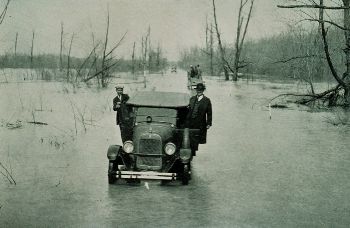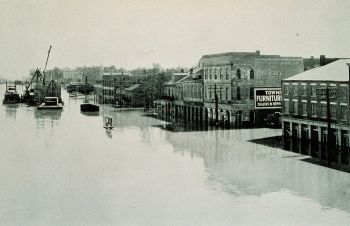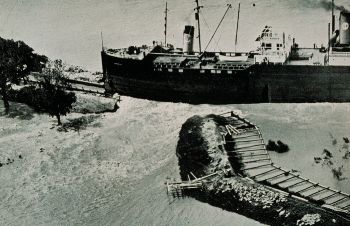by Larry
March, 2006The Nation's Worst Deluge To Date
Record rain and snowfall totals had persisted through the 1926 autumn and the winter of 1926-1927. Maximum flooding occurred in April, 1927, after hundreds of Mississippi River levies broke. At the disaster's height, there were 2,500,000-3,000,000 cubic feet of river volume per second, a record still not broken. (The Mississippi flood of 1993, for instance, involved the drainage of roughly 1,000,000 cubic feet of water a second.) The Mississippi River at one point was 60 miles wide. Over 6000 boats were employed in the rescue efforts, but with significant racial inequities in their use. The flood waters did not fully abate until September, 1927, 12 months after the deluge had begun. As one might expect, with such a scale of devastation and so huge a relief and reconstruction effort required, there were large social or political issues and consequences. As the flood crest was roaring down the Mississippi, Blacks were pressed into service at gunpoint above New Orleans to help shore up the levees. When it seemed that the city and many of its wealthy would be ruined if drastic action were not taken, a large quantity of dynamite was used to destroy a levee at Caernarvon, LA. There is controversy about whether this step had been required. Some think levee breaks farther upriver would have prevented much New Orleans destruction in any case. But once the Caernarvon levee had been destroyed, a huge amount of water poured through, with terrible consequences for downstream marshland and already poverty stricken Blacks then living in the path of the diverted flood, especially in St. Bernard Parish. Among other incidents, a group of 13,000 African-American refugees were stranded for several days without food or water. Local authorities insisted that the concerns and needs of Whites be resolved before assisting in their plight. Numerous scandals involved the mistreatment, even enslavement, of African-Americans, many of whom were forced to work on flood abatement or refugee projects for Whites.
Prior to the 1926-1927 flooding, the US had a quite limited policy of managing "levees only," with very little other involvement in water flow engineering. It is now thought that the levees, which had been put in place without adequate planning, had a direct impact on the severity of the disaster. Afterward, the central government would play an integral part in all aspects of waterway management, including the system-wide planning, construction, and maintenance of dams, levees, and misc. flood control measures.
In other ways too the disaster affected how Americans viewed the role of government. Never before had there been such agreement on the need for a strong federal bureaucracy to take charge of projects for the prevention of or recovery from big disasters. Hoover in 1927 had refused to use a federal surpus for flood victim relief. Private corporations he established for the reconstruction were failures. But most people in the country believed the central government ought to have been more helpful. Responding to this sentiment, in 1928 Congress passed the Flood Control Act. It required the greatest federal expenditues since the First World War. For better or worse, the precedent (on which FDR capitalized) had been set for much greater federal involvement in local or state issues, a radical change which has affected politics and policies down to the present.
Another major consequence of the disaster involved population shifts. Just as may now be the case with many displaced Katrina victims, hundreds of thousands whose homes and livelihoods were destroyed in the South migrated to new, more promising areas. The effect was most pronounced among Blacks. Leaving the South permanently, many tens of thousands would swell African-American communities in Los Angeles, Chicago, New York, Detroit, and other cities.
Sources: Presence of Mind - After the Deluge. John M. Barry in Smithsonian, Vol. 36, No. 8, pages 115-121; November 2005. Great Mississippi Flood of 1927. Available at Wikipedia - The Free Encyclopedia. Fatal Flood. Available at PBS - American Experience. Science Question of the Week. Available at NASA - Goddard Space Flight Center. Interview with Pete Daniel: The Great Flood of 1927. Rick Shenkman in History News Network. |


